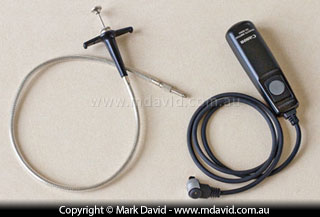
It’s one of the most basic things involved in driving a camera. Here’s what shutter speed means.

This mouse was on a swimming pool filter hose that was vibrating up and down very quickly. To freeze the action and get a clear picture of the little guy required a very fast shutter speed (2,500th second).
What is it?
When you take a photo, your camera exposes your sensor (or film) to light. The shutter speed determines how long that exposure lasts. Shutter speed can make an enormous difference to how a photo turns out.
But first …
This article assumes you’re starting to venture beyond the Auto settings of your camera. Because if you work in Auto mode, your camera makes all of the shutter speed decisions for you.
Why it’s important
The longer the shutter is open, the more light is captured, which means your image gets brighter. So shutter speed is one of the things controlling how light or dark photos are. If the shutter speed is too long/slow then your image will be too bright (overexposed). Or too fast and it comes out too dark (underexposed). So you want to get your shutter speed just right.
But there’s another really important thing about shutter speed: if your subject (or your camera) moves while the shutter is open, then the subject will be smeared across your image in what’s called motion blur. Motion blur is one of the most common causes for fuzzy images. So most of the time you want to choose a shutter speed that’s fast enough to avoid that problem. This is why photographers often want to take control of their shutter speed if their subject is moving.
Getting it right
Modern digital cameras are pretty smart. They set your shutter speed automatically according to how much light there is in the scene and also according to what other settings are being used in your camera at the time.
If you want, you can take control of your shutter speed. Switch your camera to either shutter speed priority mode (sometimes called Time Value priority mode) or manual mode, and then you can tell your camera which shutter speed to use.
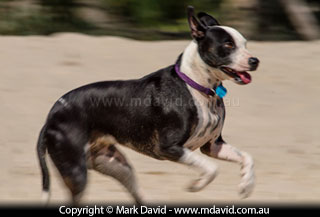
In the 100th of a second that the shutter was open, the dog moved enough to record a noticeable smear of motion blur. I could have taken this same photo at 1,000th of a second shutter speed to eliminate almost all of that motion blur. But motion blur isn’t always a bad thing! It can add a dynamic feel to a picture and some nice contrast between the blurry bits and the sharp bits. Seriously, it all comes down to what you think looks best.
Shutter speed priority
Digital SLR cameras have a bunch of modes to choose from. I’ve already briefly mentioned Auto mode, where the camera chooses all your settings. But once you outgrow Auto mode, you have the option of some other modes, including shutter speed priority mode.
When you select shutter speed priority, your camera sticks with whatever shutter speed you choose, and then figures out what the other settings (aperture and ISO) based on that starting point.
So any time you want to take charge of the shutter speed, you only have to select shutter speed priority (some cameras call it ‘Time Value Priority’) and then pick the shutter speed you want. The camera will then figure out the aperture and ISO settings. Alternatively, you can select manual mode, in which case you select the shutter speed and the aperture setting.
A bare minimum
If you like to work without a tripod and hold your camera in your hand then the blur that’s caused by camera shake can be an issue. But not a big issue, because it’s easily managed.
When I was learning photography at art college my lecturer told me never to use a camera hand-held with a shutter speed set anything slower than 30th second. I think that’s a pretty good rule and I still stick to it. And if you’re using a lens that’s longer than 30mm, then use the focal length number as a minimim shutter speed.
Huh?
Okay, what I mean is, imagine you have a telephoto lens on your camera. Telephoto lenses are the long ones. They come with focal lengths of 200, 300, or 400 or more millimetres of focal length. So if you have a 200mm lens, then use a 200th second shutter speed. 400mm lens with a 400th second shutter speed. Of course those are the minimum shutter speeds. It certainly won’t hurt if you go faster.
You see, telephoto lenses don’t just magnify the scenery — they also magnify the effects of camera shake. That’s why they need those faster shutter speeds.
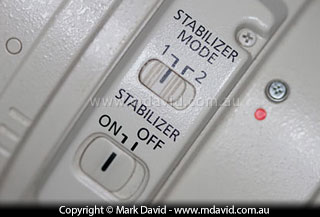
Image stabilization allows for hand-held photography at slower shutter speeds.
Image Stabilization
Modern cameras and lenses sometimes have a feature called image stabilization, or at least that’s what Canon calls it. Nikon calls it Vibration Reduction and Sigma calls it Optical Stabilization. But whatever you call it, it’s a great feature to use. That’s because it reduces the amount of camera shake blur by reducing the amount of jiggling in the image being focused onto your sensor. With modern image stabilisation happening inside your camera/lens you can often go for much slower shutter speeds than you could without it.
Of course, image stabilization won’t stop motion blur if it’s your subject that’s doing the moving. All it does it reduce the effects of camera shake.
Motion blur
When something is moving quickly you need a fast shutter speed to ‘freeze’ the action. Likewise, a slow shutter speed will allow the motion to be captured as a blur in your image. It’s up to you to decide which effect you want. Because sometimes some blur can look great.
Times when a slower shutter speed is handy
Okay, so it’s no secret that I enjoy taking photos of wildlife. A lot of wildlife moves quickly and so I often use a fast shutter speed, like 1,000th second. But if you don’t go too fast with your shutter speed, then you can get some really nice effects too. Because blur is not always bad.
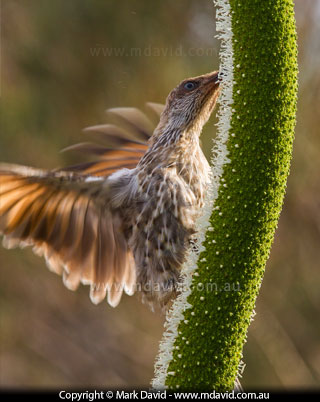
In this photo of a Little Wattlebird, the shutter speed was 500th second. Although that might seem fast, it was actually slow enough to capture some nice motion blur in the wings.
Have a look at this picture of a bird. I used a shutter speed of 500th second and the result was some motion blur in the wings which I think enhances the photo. If I’d used 1,000th of a second that motion blur would have been halved and I don’t think the result would have been as nice. Now, I could have gone a whole lot slower. For example, 60th second. If I’d done that, then chances are that not only would the wings look heaps more blurred, but the rest of the bird would look pretty fuzzy too. Because even though the bird’s body wasn’t moving as much as the wings, it would still have been moving enough to cause noticeable blur at 60th second. You see, after a while, you get a feel for what different shutter speeds are likely to do. Of course, maybe you do want to get a picture where the entire bird is blurred. It’s your choice, and your digital SLR gives you the options.
Times when a faster shutter speed is handy
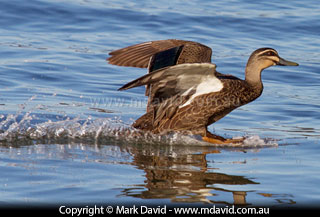
A shutter speed of 1,250th second allowed me to ‘freeze’ the individual droplets of spray in this photo of a Pacific Black Duck.
When you want to freeze some action, a fast shutter speed will do it. One example is when you want to capture individual droplets of water in spray. 1,000th second or faster will usually do the job.
Limits
Unfortunately you can’t just keep reaching for faster and faster shutter speeds all the time. There are limits to how fast you can go. First of all, there’s a physical limit in how fast your camera can open and close its shutter. And secondly, there’s a limit to how fast your camera can get sufficient light for a decent exposure.
You see, when you halve your shutter speed (for example, go from 500th second to 1,000th second) you halve the amount of time your sensor is exposed to light. To make up for that, your camera is going to want to open up your lens more (a bigger aperture). And all lenses have a maximum aperture beyond which your camera can’t let in any more light.
Or it might reach for a higher ISO (increased its sensitivity to light). But cameras have their limits there too.
If you’re working in extremely bright light, then chances are you can use very fast shutter speeds without running into problems. But if the light is weak then you quickly run into the limits of how fast your shutter speed can realistically go.
The slowest possible shutter speed
Theoretically, you can keep your shutter open forever. But in the real world I think there’s a limit.
When you choose your shutter speed, your camera should have a ‘B’ setting as one of its options. Chances are that it could be one of the options on your camera’s mode dial. If you choose B, then your camera will have its shutter open for as long as you hold the shutter button down. There’s a bit of a trap there of course. Because if you’re holding down your shutter button for a long time and then releasing it, you’re likely to jiggle your camera a little bit during the exposure, and that will result in motion blur. So you need to do a couple of things:
- Mount your camera onto a tripod and …
- use a cable release to fire your camera. What a cable release does, is to give you a button at the end of a short cable. When you press the button, the vibrations don’t travel all the way down the cable and so your camera doesn’t get jiggled.
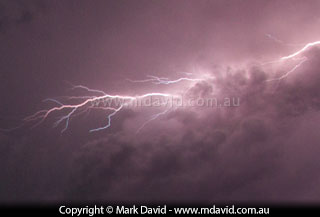
This photo of lightning was taken using the ‘B’ shutter speed setting.
